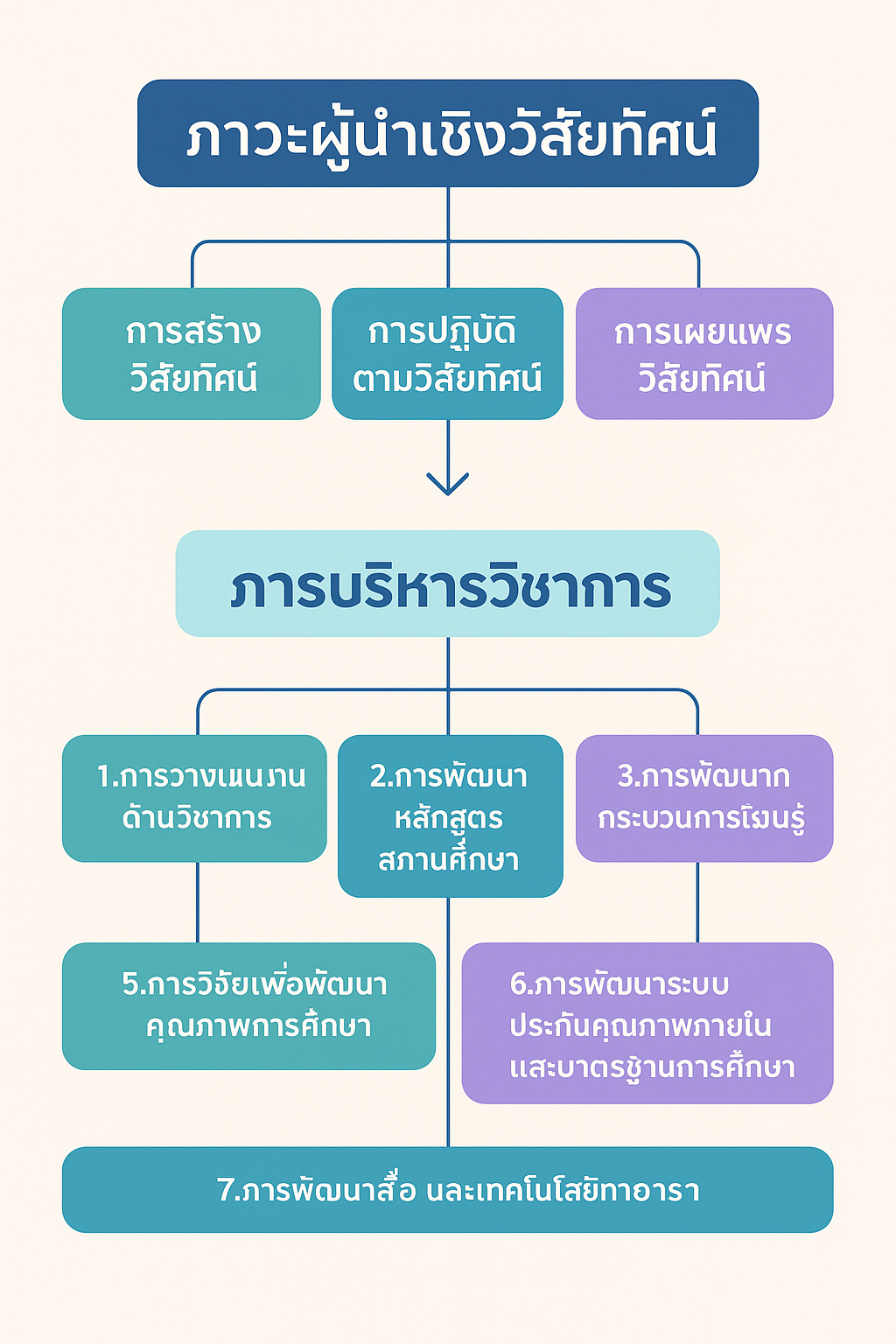THE RELATIONSHIP BETWEEN VISIONARY LEADERSHIP AND ACADEMIC ADMINISTRATION OF ADMINISTRATORS UNDER THE RAYONG PRIMARY EDUCATION AREA OFFICE 2
Abstract
This research aimed to 1) study the visionary leadership of school administrators under the Office of the Primary Educational Service Area, Rayong Area 2; 2) study the academic administration of school administrators under the Office of the Primary Educational Service Area, Rayong Area 2; and 3) study the relationship between visionary leadership and academic administration of school administrators under the Office of the Primary Educational Service Area, Rayong Area 2. This research was a quantitative research. The sample consisted of teachers. The sample group used in this research was 272 teachers under the Office of the Primary Educational Service Area, Rayong Area 2, academic year 2025. The number of schools selected was randomly selected by district using a simple random sampling method. The research instrument was a 5-level rating scale questionnaire with a reliability of 0.95. The statistics used for data analysis included frequency, percentage, mean, standard deviation, and Pearson's product moment.
The research results found that 1) the visionary leadership of school administrators in Rayong Primary Educational Service Area Office 2 was at a high level overall. When considering each aspect, it was found that being a good role model had the highest mean at a high level. 2) Academic administration found that overall academic administration was at a high level. 3) The correlation coefficient between visionary leadership and academic administration of administrators was at a high level. The relationship in each aspect found that 1. Visionary leadership was at a high level (rxy = 0.847). When considering each aspect, it was found that all aspects were at a high level of relationship. From highest to lowest, they were vision dissemination (r = 0.801), good role model (r = 0.788), vision implementation (r = 0.775), and vision creation (r = 0.727), respectively.
References
กระทรวงศึกษาธิการ. (2552 ก). หลักสูตรแกนกลางการศึกษาขั้นพื้นฐาน พุทธศักราช 2551. กรุงเทพฯ: โรงพิมพ์ชุมนุม สหกรณ์การเกษตรแห่งประเทศไทย.
จีระพร เรืองจิระชูพร. (2553). องค์การสมัยใหม่และการจัดการ. กรุงเทพฯ: มหาวิทยาลัยธุรกิจบัณฑิตย์.
นพรินทร์ สุบินรัตน์. (2018). ความสัมพันธ์ระหว่างภาวะผู้นำเชิงวิสัยทัศน์ของผู้บริหารสถานศึกษากับประสิทธิผลของโรงเรียน สังกัดสำนักงานเขตพื้นที่ การศึกษามัธยมศึกษา เขต 19.
นิกัญชลา ล้นเหลือ. (2554). โมเดลสมการโครงสร้างภาวะผู้นำเชิงวิสัยทัศน์ของผู้บริหาร สถานศึกษาขั้นพื้นฐาน. วิทยานิพนธ์ กศ.ด., มหาวิทยาลัยขอนแก่น. จังหวัดขอนแก่น.
นพรินทร์ สุบินรัตน์ (2561).ความสัมพันธ์ระหว่างภาวะผู้นำเชิงวิสัยทัศน์ของผู้บริหารสถานศึกษากับประสิทธิผลของโรงเรียน สังกัดสำนักงานเขตพื้นที่ การศึกษามัธยมศึกษา เขต 19.วารสารอิทนิลทักษิณสาร. ปีที่ 13 ฉบับที่ 3 (พิเศษ) (2018): มกราคม - ธันวาคม 2561 ฉบับพิเศษ
บุญชม ศรีสะอาด. (2553). การวิจัยเบื้องต้น (ฉบับปรับปรุงใหม่) (พิมพ์ครั้งที่ 8). กรุงเทพฯ : สุวีริยา สาส์น.
เบ็ญจมาศ หนูไชยทอง (2561). ความสัมพันธ์ระหว่างภาวะผู้นำเชิงสร้างสรรค์ของผู้บริหารสถานศึกษากับประสิทธิผลของโรงเรียนตามความคิดเห็นของครู สังกัดสำนักงานเขตพื้นที่การศึกษา ประถมศึกษาสุราษฎร์ธานี เขต 1. บัณฑิตวิทยาลัย มหาวิทยาลัยราชภัฏสุราฏร์ธานี. http://ir.sru.ac.th/handle/123456789/622. ค้นเมื่อวันที่ 22 พฤษภาคม 2564
หทัย ศิริพินผล. (2556). แนวทางการพัฒนาการบริหารงานวิชาการโรงเรียนบ้านกระทุ่มล้ม (นคร ราษฎร์ประสิทธิ์).
สวัสดิ์ชัย ศรีพนมธนากร (2561) กระบวนการพัฒนาครูด้วยระบบหนุนน าต่อเนื่องเพื่อพัฒนาทักษะแห่งศตวรรษที่ 21 ของนักเรียนในจังหวัดจันทบุรี. วารสารบัณฑิตศึกษา มหาวิทยาลัยราชภัฏวไลยอลงกรณ์ ในพระบรมราชูปถัมภ์ ปีที่ 12 ฉบับที่ 3 กันยายน – ธันวาคม 2561
อุไรวรรณ ภูชาดา (2558) การพัฒนาตัวบ่งชี้ภาวะผู้นำเชิงวิสัยทัศน์ของผู้บริหารสถานศึกษาในสังกัดสำนักงานเขตพื้นที่การศึกษาประถมศึกษาภาคตะวันออกเฉียงเหนือ
Bennis, W& Nanus, B. (1997). Leaders: Strategies for Taking Charge. Harper Collins New York, NY
Braun, Jerry Bruce. (1991). An analysis of principal leadership vision and its relationship to school climate. Dissertation abstract international, 52(4), 1139-A.
Boles, H.W. and Davanport, J.A. (1975). Introduction to Education Leadership. New York: Harper and Row.
David C. & Thomas, D.A. (1989). Leadership in Organization. (2 nd ed). Englewood cliffs, NJ : P Hall.
Dubrin .J. 1998. Leadership research finding : Practice and skills. Boston Houghton : Mifflin Company
Jacob, T.O. (1970). Leadership and Exchange in Formal Organizations.
Alexandria,Washington: Human Resources Research Organization.
Kapur, S. (2007). How a Visionary Leader is made. Retrieved from
Licata, J.w. and Other. (1990). Principal Vision, Teachers Sense of Autonomen and Enviroment
Robustness. Journal of Educational Research.84(2) ; (November- December)
Sergiovanni, T. J., Kelleher, P., McCarthy, M. M., & Wirt, F. M. (2004). Educational governance and administration (5thed.). Boston: Pearson Education.
Stogdill, R. M. (1974). Handbook of leadership. New York: The Free Press.
Zaccaro, S. J., & Banks, D. (2004). Leader visioning and adaptability: Bridging the gap between research and practice on developing the ability to manage change. Human Resource Management, 43(4), 367-380.

Downloads
Published
How to Cite
Issue
Section
License
Copyright (c) 2025 Vol. 1, No. 2 (May-August) 2025

This work is licensed under a Creative Commons Attribution-NonCommercial-NoDerivatives 4.0 International License.
This article is published under a Creative Commons Attribution-NonCommercial-NoDerivatives 4.0 International License (CC BY-NC-ND 4.0), which allows others to share the article with proper attribution to the authors and prohibits commercial use or modification. For any other reuse or republication, permission from the journal and the authors is required.

